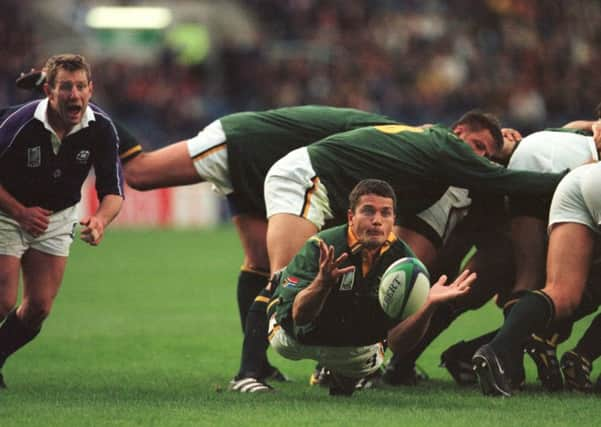Joost Van der Westhuizen's legacy will live on


It was rather in his six-year battle with motor neurone disease (MND), which has ended his life at the age of 45, that South Africa’s greatest scrum-half believed he left the most profound mark.
The full force of that claim was made obvious three years ago at a neurological care centre in Peterborough that Van der Westhuizen was hoping to adopt as the template for a similar facility in South Africa.
Advertisement
Hide AdAdvertisement
Hide AdHe had by then lost the capacity for speech, though if brother Pieter placed his ear close enough he could discern meaning from what expression was left to him.
Unable to walk, Van der Westhuizen was a shell of the magnificent specimen he had been, his body collapsed in on itself, those once brilliant hands resting motionless on his lap.
There was, however, no dimming the light in the greenest of eyes, Venus-like pools that once persuaded his English counterpart, Kieran Bracken, that he might be falling in love as he caught his gaze across the scrum.
We spoke of his great moments in the service of the Rainbow Nation at a time of historic import for South Africa. Via his brother’s interpretation skills, he communicated a sense of playfulness still, saying he was lucky that Lomu fell over him after smashing through the tackle of captain Francois Pienaar.
Such was the threat posed by Van der Westhuizen that he was identified by Sir Clive Woodward, pictured right, as the man England had to stop in the 2003 World Cup group stages. “He did,” the Springbok said, with touching modesty.
Eight years later he would be diagnosed with the lethal condition, MND and related ALS (amyotrophic lateral sclerosis) that took him from us 48 hours ago.
The doctors advised that he had 24 months to live at the point of discovery, in 2011, to which he retored in an interview at the time: “That’s bulls**t. You live as long as you want, as long as you are positive.
“They told me I had 24 months and I am now at 50. My mind is 100 per cent. When I think about my ALS, I think of how I talk, that my mouth and my tongue do not work. You are a prisoner in your body. It was really hard at first. But you adapt. Either you adapt or you die.”
Advertisement
Hide AdAdvertisement
Hide AdVan der Westhuizen threw himself into fundraising and awareness campaigns through his J9 Foundation. The experience forced a reordering of priorities and a re-evaluation of the man he was. Though denuded of his physical glory he was thankful to be rid of the alpha male pretensions that attended his playing career.
In his diminished state he learned what it was to be a man, and it was the contribution he made via his foundation of which he was most proud. “When I played rugby I became arrogant and I worried about myself,” he said. “Now I’m living my life the way I want to and that is to help others – and I’m having more fun.
“I have a platform and now I use it to help others. Back home we have nothing. People are dying. There is no support or care and, for me, that is not good enough. That’s why I’m here [Peterborough] to see that we have this [facility] back home.”
The J9 Foundation began to fund MND research – the first of any kind in South Africa – in 2015 and to date has provided direct support to more than 100 sufferers.
The fight goes on. Van der Westhuizen is no longer with us but, through his foundation, he continues to affect the lives of others.